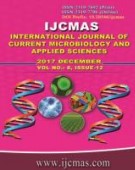


 National Academy of Agricultural Sciences (NAAS)
National Academy of Agricultural Sciences (NAAS)

|
PRINT ISSN : 2319-7692
Online ISSN : 2319-7706 Issues : 12 per year Publisher : Excellent Publishers Email : editorijcmas@gmail.com / submit@ijcmas.com Editor-in-chief: Dr.M.Prakash Index Copernicus ICV 2018: 95.39 NAAS RATING 2020: 5.38 |
Brown planthopper, Nilaparvata lugens (Stål) is a serious pest of rice across the Asian countries. This species exhibits significant wing dimorphism whereby fully developed adults (macropterous forms) are capable of flight. In planthopper species the wing form is determined by a developmental switch that is triggered by environmental factors including crowding, host plant quality, temperature and photoperiod. This study examined the influence of insect density (crowding) on N. lugens nymphal survival, nymphal duration, sex ratio, wing dimorphism, adult longevity and fecundity. Response of three BPH populations collected from Nalgonda district of Telangana, West Godavari districts of Andhra Pradesh and Ludhiana of Punjab was observed at four different insect densities i.e., 1, 20, 40 and 60 nymphs/45 days old susceptible variety TN1 plant. High nymphal density/crowding has adversely affected the nymphal survival on 5th and 10th day, nymphal duration, % adult emergence, sex ratio, adult longevity and fecundity. Nymphal density /crowding has differential influence on sex where more number of winged females and wingless males were observed at high nymphal densities but total brachypterous forms were more at increased nymphal density. Nalgonda population exhibited extreme marcopterous forms, whereas West Godavari and Ludhiana populations showed more brachypterous forms over the broad ranges of nymphal density. Populations responded similarly regarding lower nymphal survival, prolonged nymphal duration, with increasing nymphal density. Among the populations, West Godavari showed lower nymphal survival rate, shorter nymphal duration in males, lower adult longevity but higher fecundity compared to Ludhiana and Nalgonda populations.
 |
 |
 |
 |
 |